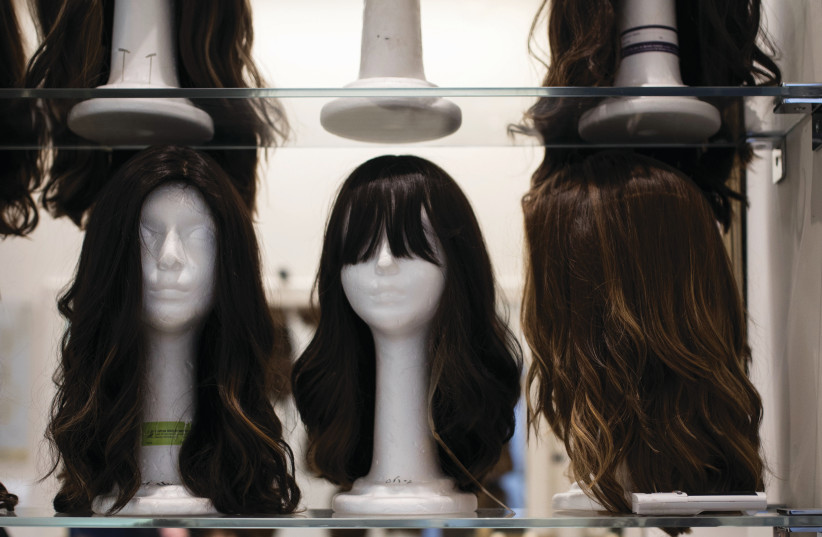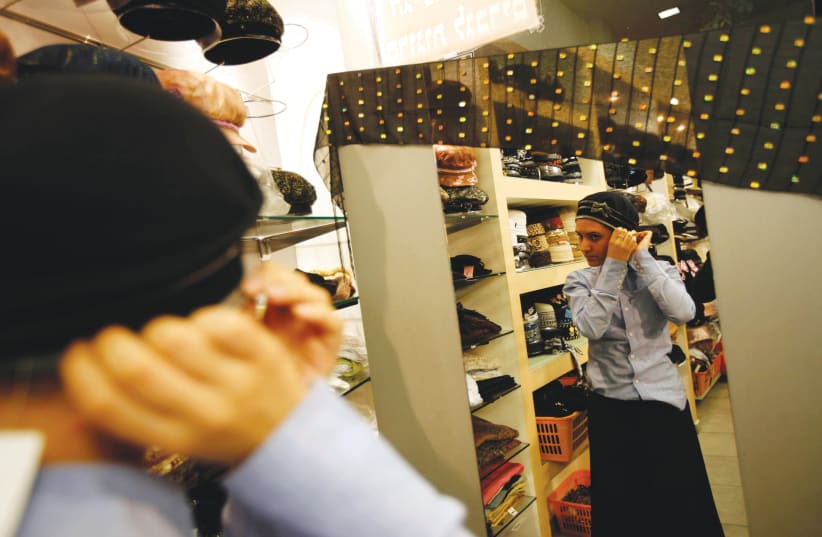As noted in the previous column, by the late 19th and early 20th centuries, in parts of Europe and its colonies, it had become common practice for religious married women to go out in public with no head coverings. While some rabbinic authorities were willing to recognize that dat yehudit no longer included head covering for married women, the majority of rabbinic opinion stood firm on the matter.
For instance, Rav Ovadia Yosef wrote, in rejection of Rabbi Joseph Messas’s halachic ruling that hair covering is no longer binding, that “we must conclude that only the basic covering of one’s hair, which is biblical in nature, is obligatory irrespective of changes in practice, and is unchanging for all time. However, with respect to the modest practices of Jewish women, whatever the contemporary practice is, although it is lenient, can be accepted.”
“We must conclude that only the basic covering of one’s hair, which is biblical in nature, is obligatory irrespective of changes in practice, and is unchanging for all time. However, with respect to the modest practices of Jewish women, whatever the contemporary practice is, although it is lenient, can be accepted.”
Rav Ovadia Yosef
Modern practice and interpretation
Several developments over the last half century should be noted when discussing women’s hair covering in modernity.
First, many women who identify as Torah observant – keeping Shabbat, kashrut and mikveh, praying in an Orthodox synagogue, sending their children to Orthodox schools – nonetheless continue the trend that began in the 19th century and do not cover their hair at all.


It is my experience that usually this is not based on strict adherence to Halacha in the manner of following Rabbi Messas, for instance. Rather, it is usually due to reasons of comfort, fashion, the custom of a woman’s mother who did not cover her hair or because it does not speak to a woman as a meaningful mitzvah.
Furthermore, it is no longer considered grounds for divorce without receiving ketubah, nor are these women prevented in any way from participating in communal events or being fully part of a religious community. In fact, a man without a kippah stands out far more than a woman without a head covering at any religious gathering, particularly since single women are expected to bare their heads in public.
Second, there has been an influx of female voices actively engaged in studying the sources and searching for significance behind the practice of hair covering. Some of these voices express a sense of the dignity inherent in the mitzvah, symbolic identification of a married woman in public, the expression of humility before God in the manner of a kippah, the need for greater modesty once married and connecting to a female ritual.
That women’s voices are weighing in on this topic is, in and of itself, an innovation. For the first time in Jewish history, women are being heard as they embrace and/or grapple with the gender differences in halachic Judaism.
While attempts to find meaning are always welcome, it is also important to recognize that none of the reasons mentioned above (dignity, symbolic identification, humility) are explicitly stated in the rabbinic and halachic sources.
The source in tractate Ketubot states that a married woman must cover her head when going out in public, along with a series of other behaviors that mandate her modesty in public. In tractate Berachot, the concern is solely over a man’s sexual arousal.
In other words, interpretive meaning has the potential to infuse a given ritual with greater significance, but to my mind it does not fully uproot any of the earlier original discussions that gave shape and definition to the practice.
Third, many young women, particularly in Israel, who cover only a fraction of their hair have come to regard hair covering as a women’s mitzvah, seeking to observe it on their own terms outside of the parameters set out by rabbinic authorities.
As often happens, particularly for women learning about gendered mitzvot, there can be a simultaneous movement toward and away from the practice. Many are not interested in protecting men from erva or in measuring how much of their head must be covered by estimating the area of a tefah. At the same time, they are attracted to a Jewish female ritual dating back thousands of years. They choose to cover their head symbolically as a sign of their status as married women and in connection to an established women’s practice.
One of the styles most reflective of this trend is a wide headband which covers the top of the head but very little hair. According to Rav Ovadia’s definition above, that any practice of head covering practiced by the daughters of Israel is legitimate, such a hair covering could be validated by rabbinic authorities, although in practice it is not. Nonetheless, many women who in previous generations might have gone with uncovered heads commit to wearing these headbands. In fact, many communities recognize that such head coverings are a statement of marital status.
FINALLY, SIMILAR to the headband, the wig as a head covering is a fascinating issue in which rabbinic authority interacts and, to some degree, clashes with women’s desire to be fashionable and look attractive.
It seems that as far back as the Mishna in Shabbat, women wore wigs made out of human or animal hair. It is not clear whether the mishnaic wig was similar to the human hair wigs worn by religious women today or were used only as hair extensions, to thicken a woman’s own hair. What is clear is that she is considered to be more attractive with it than without it, which is why she is allowed to wear it in the courtyard on Shabbat.
In some ways, wigs seemed to be an ideal solution, particularly in communities calling for women to cover all of their hair because of erva. In addition, by wearing a wig, she remains attractive to her husband, an ongoing concern addressed by the sages and the post-Talmudic authorities with regard to hair and head coverings.
While a permissive halachic framework was established, wigs remained and continue to remain a subject of controversy given the increased attraction and attention they can bring to a married woman.
There are rabbinic voices that forbid women from wearing attractive wigs, due to concerns for immodesty and latent promiscuity. In contrast, Rav Moshe Feinstein ruled that wigs are permissible and rejected any concern for immodesty even when a wig strongly resembles or exceeds the attractive quality of a woman’s hair. Finally, the last Lubavitcher rebbe, Rav Menachem Mendel Schneerson, strongly endorsed the wearing of wigs. The Rebbe felt so strongly about wigs being an ideal form of hair covering that a special fund was established in Chabad for needy brides to assist them in buying beautiful wigs that would assure their complete compliance with the full mitzvah of hair covering.
Today the technology of wigs has evolved (and along with it the increased cost) so that the top of the wig is engineered with materials that completely mimic a woman’s scalp and make it even harder to tell when a woman is wearing a wig.
It is interesting that in Modern Orthodox communities, the full wig quickly evolved into the fall, a hair piece which starts farther back on the woman’s head, allowing her natural hair to blend seamlessly into the added hair. The adaptation of the wig into the fall, with better-quality engineering and higher-quality hair, shows how women have extended the boundaries of the permissible by adapting the specific medium in a way that empowers and beautifies them without concern for the particularities of the halachic discourse.
Even in Sephardi communities, it has proven impossible to ban the wearing of wigs, despite Rav Ovadia strongly condemning their use and criticizing Sephardi women who reject their own traditions and rabbinic rulings in favor of the customs and rulings of Ashkenazi rabbis.
Nonetheless, women in those communities are increasingly choosing wigs, influenced and inspired by their haredi Ashkenazi counterparts.
As the world has become smaller and women from communities with different customs and practices live next door to one another, women are taking ownership of a practice they have come to define as a mitzvah by deciding how to cover their hair, influenced more by other women than by straightforward rabbinic instructions, and thus, perhaps, reasserting the truest ideal of dat yehudit practice. ■
The writer teaches contemporary Halacha at the Matan Advanced Talmud Institute. She also teaches Talmud at Pardes, along with courses on sexuality and sanctity in the Jewish tradition.
